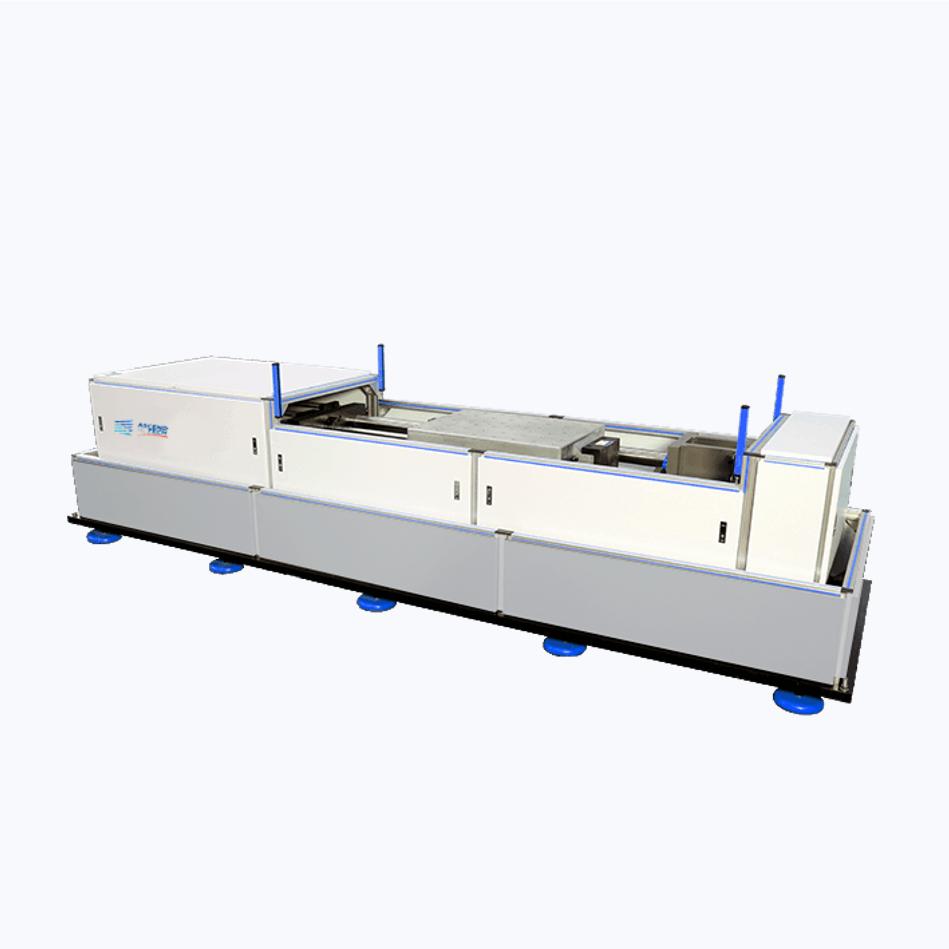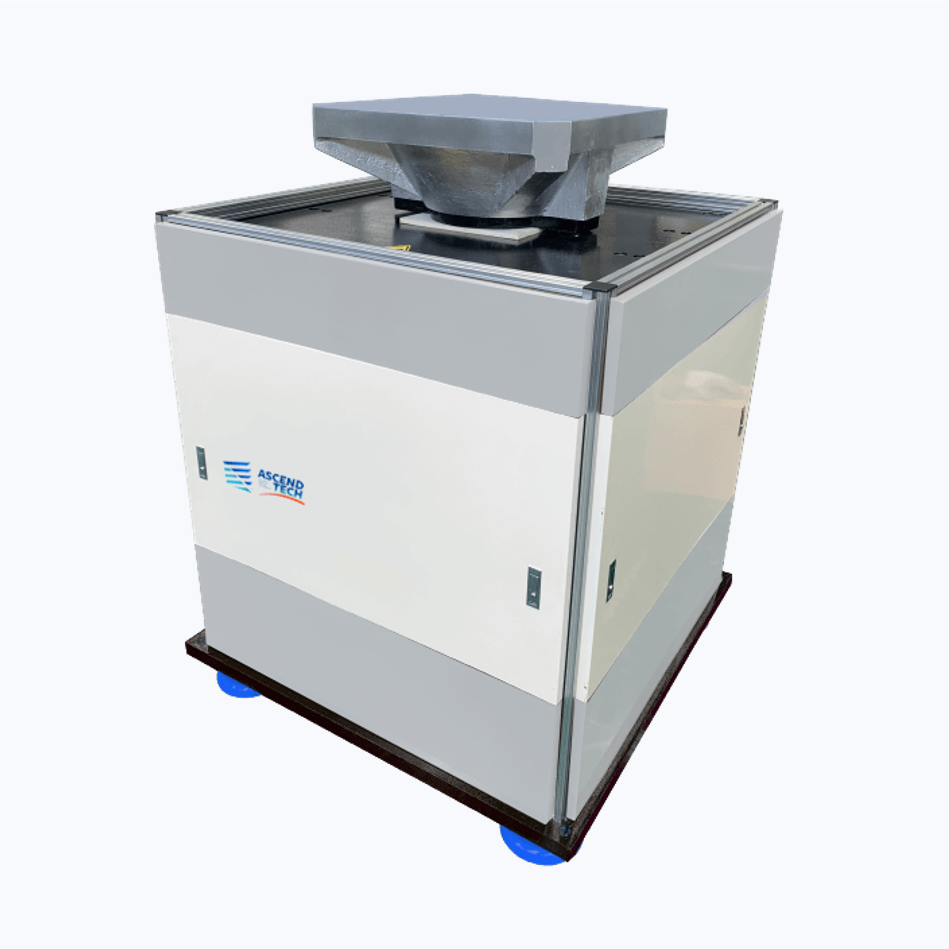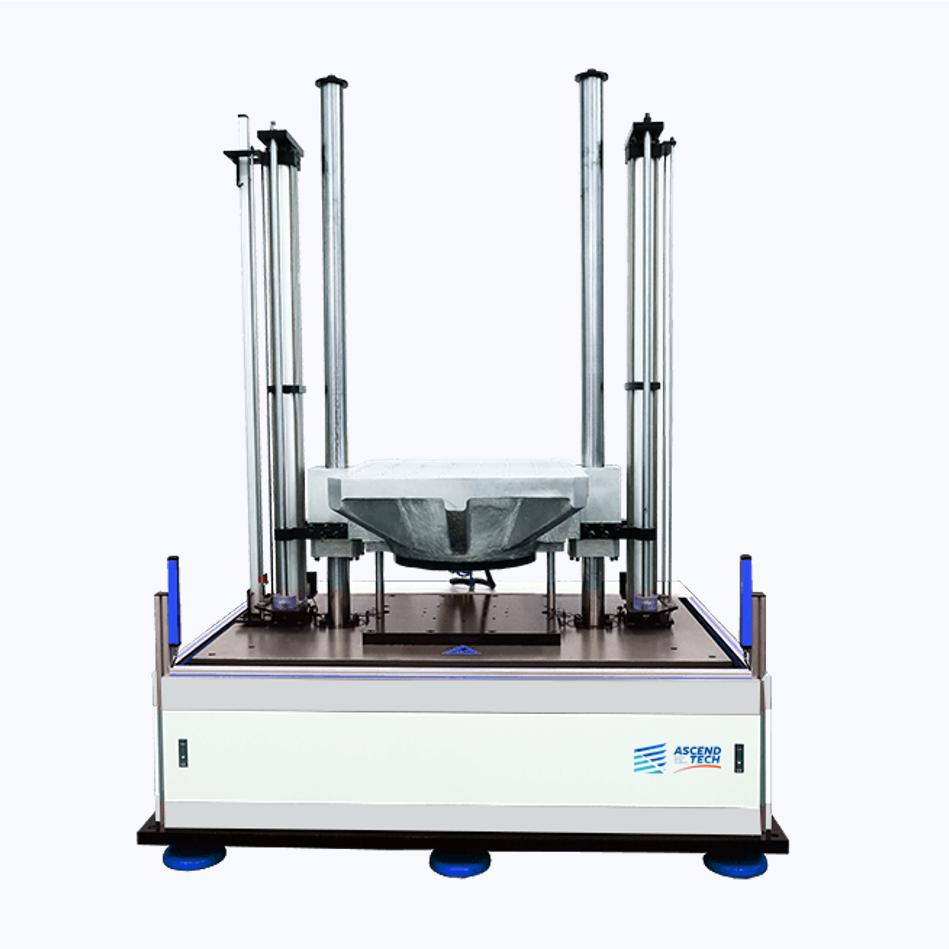Shock/Bump Test System
Wide range of high-quality Shock/Bump Test Systems designed to meet the requirements of endurance testing and offer superior performance as well as reliability.
A bump test machine is intended to simulate the effects of repetitive shocks likely to be experienced by components when they are transported in a vehicle from one place to another place or installed for its application on a moving vehicle or platform. The tests can be performed in accordance with worldwide standards such as IS, BS, MIL, DIN, EN, ISO, IEC, DEF & ASTM.
PVS Pneumatic Vertical
Shock Test System
-
PVS series pneumatic vertical shock test system is featured with advanced design, high degree of automation and reliability, simple operation, and convenient maintenance. The system meets the requirements of both shock and bump tests, can perform conventional half-sine wave, post-peak sawtooth wave, trapezoid wave, and other waveform shock tests.
Pneumatic drive, simple structure, and high reliability, without hydraulic leak risk.
Maximum shock rate up to 120 times/min.
Impact testing for small pulse lower to 0.3ms
Shock testing machine with high acceleration is up to 3000g
It can easily realize large shock pulse width and small overload test.
With a fast shock rate compared to motor or hydraulic driven bump table, it has higher reliability and better bump waveform.
The speed and rate of shock can be easily controlled by adjusting the gas pressure.
IPS-2000 shock control and measurement system can perform manual shock, continuous shock (bump test), single shock, and interval shock.
Built-in brake mechanism ensures the safety of operation in any situation.
-
MIL-STD-810F
IEC68-2-27
UN38.3
IEC62281
IEC62133-2
UL2054
IEEE1625
SAEJ2929
IEC62660-2
ISO12405-3
UL2580
PHS Pneumatic Horizontal
Shock Test System
-
The PHS series shock test system is used to measure and determine the horizontal impact resistance of a product or package, and to evaluate the reliability and structural integrity of the test unit in a horizontal impact environment. The system can perform conventional half-sine wave, post-peak sawtooth wave, or trapezoid wave shock test to realize the shock energy that the product is subjected to in the actual environment, thereby improving the product or packaging structure.
Windows-based stable control system, full-automatic remote-control interface
Pneumatic cylinder driving with advantages of large driving force, short accelerating stroke, low cost and pollution free.
Trapezoidal guide posts: large supporting force, good lubricity and full-automatic positioning table.
Automatic control of shock speed: the shock overload value is achieved by adjusting the air pressure. After the cylinder pressure is set, the system will automatically control the shock speed with high accuracy and good repeatability.
Adopts the high strength and hardness cast aluminum table, which has a high first-order resonance frequency, featured with low noise and no clutter
The most reliable double-brake system: effectively avoids secondary rebound collisions, more securely positioning the table, and more reliably guarantees the safety of the operator.
Multiple waveforms: can perform conventional half-sine waves, post-peak sawtooth waves, or trapezoid waves.
Easy installation: the device comes with a base, due to the short driving stroke of the pneumatic cylinder, the footprint is small.
Integrated control & measurement system: the system comes with a variety of waveform tolerance bands that comply with the MIL-810 standard, automatically generate test reports after the test is completed.
System scalability: the system can be designed as a bidirectional shock according to user needs, saving test time more effectively.
-
MIL-STD-810F
IEC68-2-27
UN38.3
IEC62281
IEC62133-2
UL2054
IEEE1625
SAEJ2929
IEC62660-2
ISO12405-3
UL2580
HES High Energy
Shock Test System
-
HES series high energy shock test system is specially designed to meet the requirements of military and automotive testing. The system adopts the principle of pneumatic energy storage expansion. By adjusting the inflation pressure, various high-level acceleration tests can be easily implemented in a short stroke.
For the high-G classic shock test, it's equipped with the corresponding shock amplifier to complete high-peak shock test.
Windows-based stable control system, full-automatic remote-control interface
Pneumatic cylinder driving with advantages of large driving force, short accelerating stroke, low cost and pollution free.
Automatic control of lifting height with high accuracy and good repeatability
Adopts the high strength and hardness cast aluminum table, which has high first-order resonance frequency, featured with low noise and no clutter
The most reliable double-brake system: effectively avoids secondary rebound collisions, more securely positioning the table, and more reliably guarantees the safety of the operator.
Easy installation: the device comes with a base, due to short driving stroke of the pneumatic cylinder, the footprint is small.
HES is specialized for high-energy shock testing, HES is capable of doing following test:
1. 60g~45ms
24g~50ms
90g~20ms
150g~15ms
70g~45ms
300g~11ms
200g~10ms
-
MIL-STD-810F
IEC68-2-27
UN38.3
IEC62281
IEC62133-2
UL2054
IEEE1625
SAEJ2929
IEC62660-2
ISO12405-3
UL2580
BVS Bidirectional Vertical
Shock Test Systems
-
BVS series pneumatic bidirectional vertical shock test system is the novel designed and developed for large specimens that cannot or are not easy to turn over, especially adopt for battery testing. It can complete vertical upward and downward shock test in one test stand without moving the UUT.
Pneumatic drive, no pollution to the environment
One machine with multiple functions, one clamping, to complete the upward and downward shock and bump tests, with high efficiency
Built-in pneumatic brake mechanism, safe and reliable
One-machine management for control and measurement, convenient operation
Air springs and dampers are used to reduce vibration, and the installation is free of foundation
-
MIL-STD-810F
IEC68-2-27
PB Pneumatic Bump
Test Machine
-
The PB series pneumatic bump test machine replaces the traditional mechanical cam-type crash bench and is suitable for repeated impacts on electronic components, equipment and other electrical and electronic products during transportation or working.
Fully pneumatic driven, clean and environmentally friendly, good repeatability and high reliability.
Control the frequency of collisions by adjusting the gas pressure to achieve continuous high-frequency collisions.
Test time and collision frequency can be set arbitrarily, and it will stop automatically after the test is completed
Shock test for battery packs more than 500kg, we recommend use PB bump test machine
PB bump test machine is suitable for large size battery pack, and with middle acceleration and large pulse duration, such as:
16g~60ms
24g~16ms
25g~15ms
50g~11ms
50g~15ms
-
MIL-STD-810F
IEC68-2-29
HIS High Impact
Shock Test System
-
High impact shock test system meets MIL-S-901D standard which covers shock testing requirements for ship board machinery, equipment, systems, and structures, excluding submarine pressure hull penetrations. The purpose of these requirements is to verify the ability of shipboard installations to withstand shock loadings which may be incurred during wartime service due to the effects of nuclear or conventional weapons.
AscendTech provides lightweight & medium weight high impact shock test system in accordance with one of the following test categories, as specified.
Lightweight. The lightweight test is a test performed on the lightweight shock machine. Weight of the test item including fixture to attach it to the test machine shall be less than 550 pounds.
Medium weight. The medium weight test is a test performed on the medium weight shock machine. Weight of the test item including fixture to attach it to the test machine shall be less than 7,400 pounds.
-
MIL-S-901D
HVS Hydraulic Vertical Shock Test System
-
HVS series full-automatic hydraulic shock test system is used to measure and determine the impact resistance of products or packaging, and to evaluate the reliability and structural integrity of products in a shock environment. The system can perform conventional half-sine wave, post-peak sawtooth wave, trapezoid wave and other waveform shock tests to achieve the shock wave and impact energy that the product is subjected to in the actual environment, thereby improving the product or packaging structure.
Windows-based stable control system, full-automatic remote-control interface
Multi-track guide posts combined with good lubricity and noise free hydraulic balance lifting system to achieve stable shifting
Automatic control of lifting height with high accuracy and good repeatability
Adopts the high strength and hardness cast aluminum table, which has high first-order resonance frequency, featured with low noise and no clutter
Built-in brake mechanism to avoid secondary rebound collisions and more secure positioning of the table
Multiple waveforms: it can perform conventional half-sine waves, post-peak sawtooth waves, or trapezoid waves
The self-buffer & vibration isolation base does not require a special foundation, and easy to install
One-stop test: built-in test standards meet various requirements to help users to complete test in one stop
-
MIL-STD-810F
IEC68-2-27
UN38.3
IEC62281
IEC62133-2
UL2054
IEEE1625
SAEJ2929
IEC62660-2
ISO12405-3
UL2580








